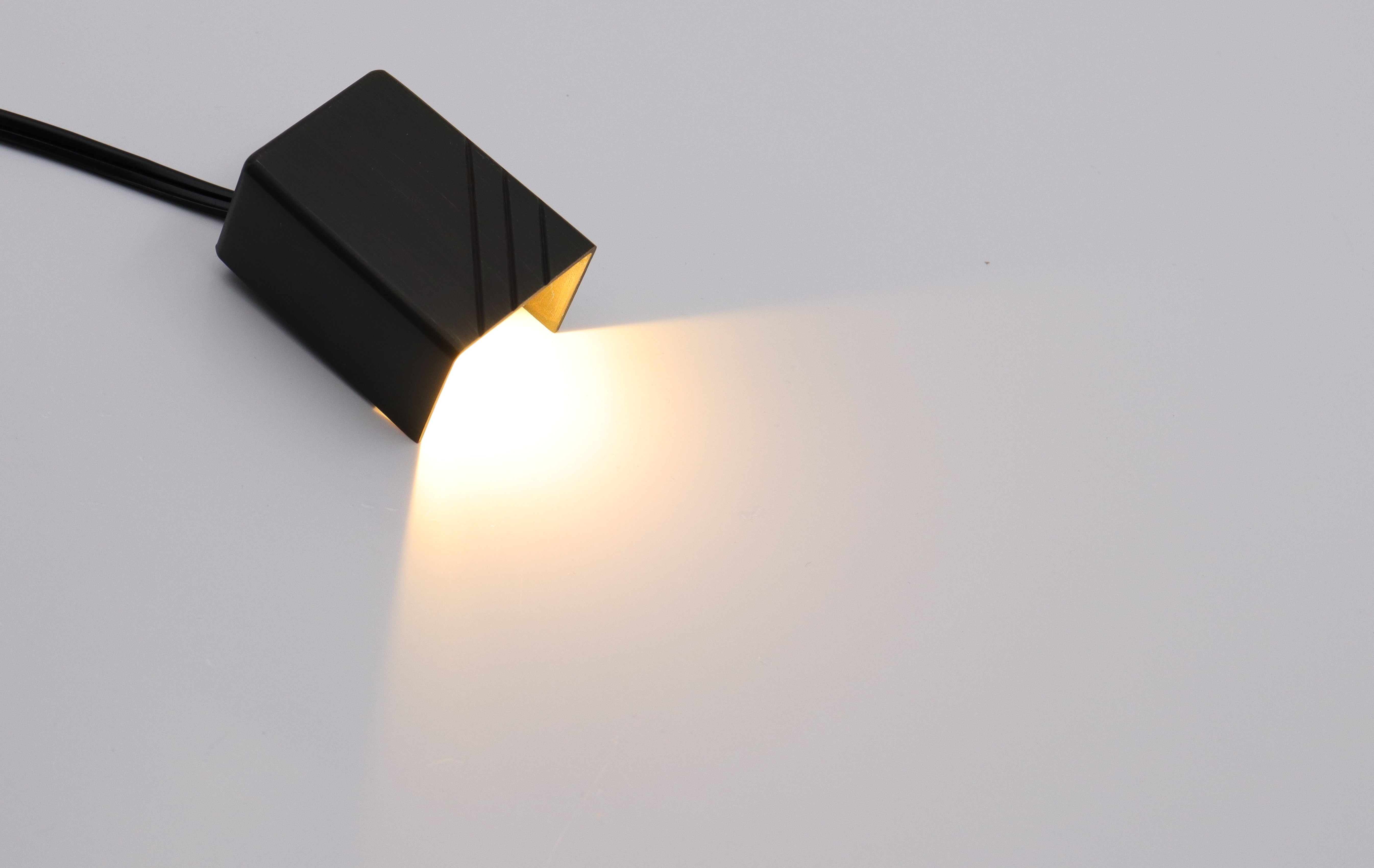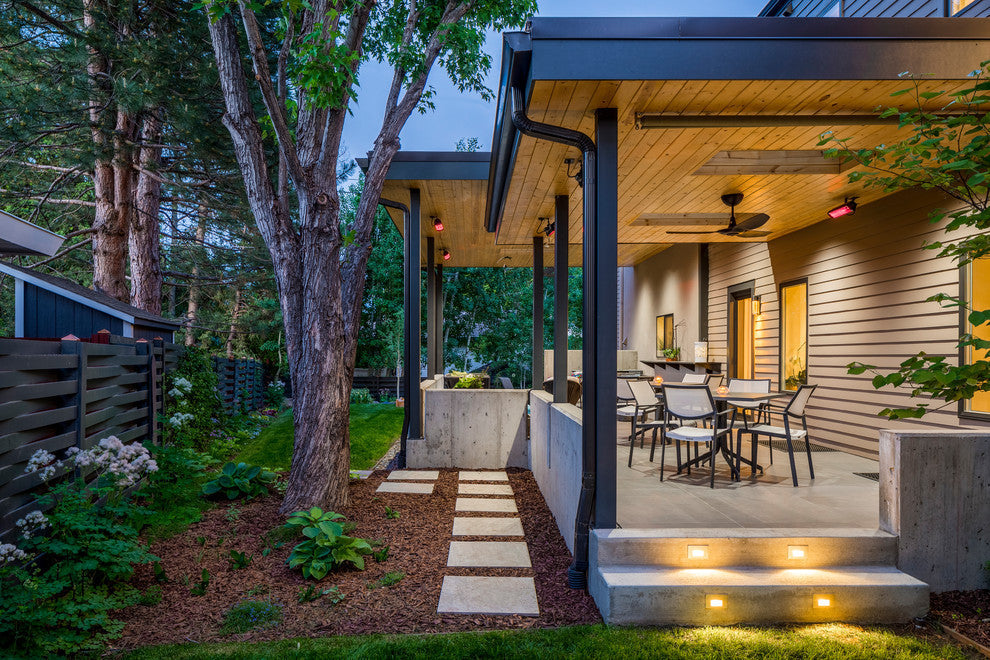|
Technique |
Description |
|
Downlighting |
Aims light fixtures directly downward to evenly illuminate an area, creating a natural-looking effect like moonlight. Used for spotlighting plant beds, gardens, trees, and statues. |
|
Uplighting |
Points light upwards, ideal for highlighting architectural or natural elements. Creates a magical moonlit effect under trees and highlights a home’s roofline. |
|
Cross Lighting |
Involves illuminating landscape from two opposite directions to eliminate shadows and evenly illuminate surfaces and objects. Showcases texture and depth of garden walls and architectural features. |
|
Grazing |
Highlights the texture of surfaces by positioning lights close to the ground, aimed at an angle. Accentuates grains, grooves, and patterns on walls, sculptures, and stonework. |
|
Silhouetting |
Places lighting behind objects to create dramatic shadows. Transforms trees, trellises, and arbors into striking silhouettes against a brighter backdrop. |
|
Shadowing |
Generates pools of light and dark by aiming lights at oblique angles. Adds depth, dimension, and intrigue along pathways or near landscape accents. |
|
Path Lighting |
Illuminates walking areas for safety and visibility. Positioned low to avoid glare, highlighting steps, ramps, and pathways with warm light temperatures. |
|
Zone Lighting |
Divides landscape into separate zones for precise control. Tailors lighting techniques and fixtures to each zone’s function, like dining areas or entryways. |
Proper outdoor lighting can transform a home, not just at night but also during the day. The strategic use of different lighting techniques draws attention to plants, pathways, structures, and other areas you want to showcase. In this blog post, we will explore some of the most popular landscape lighting techniques and how to use them effectively.
There are a variety of landscape lighting techniques that serve different purposes. Choosing the right approach depends on your home's architecture and your yard's topography. Here are some of the most popular techniques for illuminating your home's outdoor space:
1. Downlighting
Downlighting aims light fixtures directly downward to evenly illuminate an area. This technique creates a natural-looking effect, like moonlight shining down. Use it to spotlight plant beds, flower gardens, ornamental trees, and statuary. Position the fixture high enough to avoid glare and dark shadows.
2. Uplighting
Uplighting points light upwards and is ideal for highlighting architectural or natural elements. It creates a dramatic moonlit effect beneath trees and enhances features like rooflines or tree trunks.
3. Cross Lighting
Cross lighting refers to illuminating your landscape from two opposite directions. It removes shadows and evenly lights surfaces. Ideal for garden walls and architectural details to highlight texture and depth.
4. Grazing
The grazing lighting technique highlights the texture of surfaces. Grazing lights sit close to the ground and aim up at an angle. Rather than directly illuminating an object, the lighting grazes the surface to accentuate its visual textures. Grazing lighting brings out the grains, grooves, finishes, and patterns covering walls, retaining walls, sculptures, stonework, and various landscape elements.

5. Silhouetting
Silhouetting places lighting behind objects to create dramatic shadows. Trees, trellises, and arbors become striking shapes against a lit backdrop. This adds theatrical flair to walkways and seating areas.
6. Shadowing
Shadowing generates pools of light and dark by aiming lights at oblique angles. It adds depth, dimension, and intrigue. Use this technique along winding paths or accents you want to highlight in an evocative way. For example, cast intriguing patterns on the ground for a mysterious look.
7. Path Lighting
Path lighting illuminates walking areas for safety and visibility. Place fixtures low to avoid glare and highlight steps and walkways. Choose warmer light temperatures for a more inviting glow.

8. Zone Lighting
Zone lighting divides the landscape into sections. Tailor lighting styles to suit each area—dining, entryways, garden paths—providing precise control and ambiance.
How to Mix the Landscape Lighting Techniques for Better Results?
- Downlighting + Uplighting: Combine for general lighting and focal drama.
- Grazing + Architecture: Accentuate textures and structural details.
- Shadowing + Silhouetting: Artistic, mysterious effects for seating areas.
- Cross Lighting: Balanced light coverage for depth and texture.
- Pathway Lighting: Combine safety and visual appeal.
- Zone Lighting: Tailor lighting styles for different outdoor functions.
Cohesion in Lighting Design: Ensure that the various lighting temperatures and styles across these techniques maintain a cohesive look. The lighting design should feel like a natural extension of your home’s style, rather than a collection of mismatched elements.

By thoughtfully combining different methods, you can create a layered, dynamic, and cohesive lighting scheme that not only enhances security and safety but also dramatically improves the aesthetic appeal of your home's exterior.
Conclusion
The strategic use of landscape lighting techniques like downlighting, uplighting, grazing, and path lighting helps create a stunning nighttime oasis. Illuminating gardens, architectural details, trees, and pathways enhances aesthetics, safety, and security. Consider available techniques and thoughtfully place fixtures to achieve both function and beauty. Mixing approaches across lighting zones generates an inviting ambiance and showcases the best features of your property. With the right lighting design, you can craft an outdoor space that wows as the sun goes down.
Q&A About Landscape Lighting Techniques
Q: How can I determine the best lighting technique for my yard?
A: Assess plants, paths, and structures. Use downlighting for coverage, uplighting for emphasis, and zone lighting for control.
Q: How to enhance small gardens?
A: Focus on key features using uplighting or silhouetting. Add subtle path lights and use grazing to highlight textures.
Q: What’s best for showing off plant textures and colors?
A: Use uplighting and cross lighting to highlight color and depth.
Q: How to light a stone walkway?
A: Use path lighting with low glare fixtures along the edges.
Q: What fixtures are best for steps?
A: Use small step lights aimed inwards to highlight elevation changes.
Q: Warm or cool lights?
A: Warm color temperatures (2000K–3000K) feel more natural and inviting outdoors.





Leave a comment
All comments are moderated before being published.
This site is protected by hCaptcha and the hCaptcha Privacy Policy and Terms of Service apply.